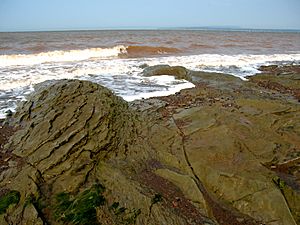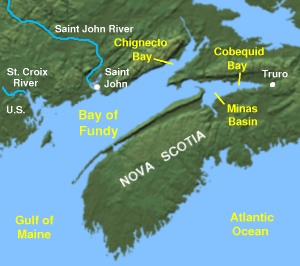Chignecto Bay facts for kids
Chignecto Bay is a large inlet, or arm, of the Bay of Fundy. It sits between the Canadian provinces of New Brunswick and Nova Scotia. The bay is separated from the Northumberland Strait by a narrow strip of land called the Isthmus of Chignecto. This area is part of the larger Gulf of Maine region.
Chignecto Bay forms the northeastern part of the Bay of Fundy. It splits off at Cape Chignecto and is marked on the New Brunswick side by Martin Head. The name "Chignecto" comes from the Mi'kmaq word Siknikt, which means "drainage place." It's also said to mean "foot cloth," possibly from an old Mi'kmaq story.
In the 1880s and 1890s, there was a plan to build a railway and canal across the land here. This project was meant to create a shortcut for ships and goods between New England and Prince Edward Island. However, after many studies, the project was stopped because it wasn't seen as a good idea for business. You can still see some parts of this old project in the Chignecto Bay area today.
What is Chignecto Bay?

Chignecto Bay is like a long arm of the Bay of Fundy. At its far end, it splits into two smaller parts:
- Cumberland Basin: This is the northeast arm of Chignecto Bay. It stretches between New Brunswick and Nova Scotia. It ends near the Tantramar Marshes and the rivers that flow into it, like the Tantramar River and Maccan River.
- Shepody Bay: This is the north arm of Chignecto Bay. It is entirely within New Brunswick. It ends where the Petitcodiac and Memramcook Rivers meet the bay.
Many smaller bays are found along the coast of Chignecto Bay. One example is Salisbury Bay, where the Upper Salmon River and Cleveland Brook flow into the bay. The village of Alma, NB is located here.
Chignecto Bay is part of a rift valley. A rift valley is a lowland region that forms where the Earth's tectonic plates pull apart. This type of valley makes up much of the Bay of Fundy.
Important Areas for Birds
The top part of the Cumberland Basin is a very important place for many shorebirds. These birds stop here during their long migrations. A large part of this area is protected as a special place for wildlife. It is called the Chignecto National Wildlife Area.
Inside this wildlife area is the John Lusby National Wildlife Area. This smaller area is about 10.2 square kilometers (about 4 square miles). It has been recognized as a Ramsar Wetland of International Importance since October 1985. This means it is a wetland that is very important for nature and wildlife around the world.
See also
 In Spanish: Bahía de Chignecto para niños
In Spanish: Bahía de Chignecto para niños


